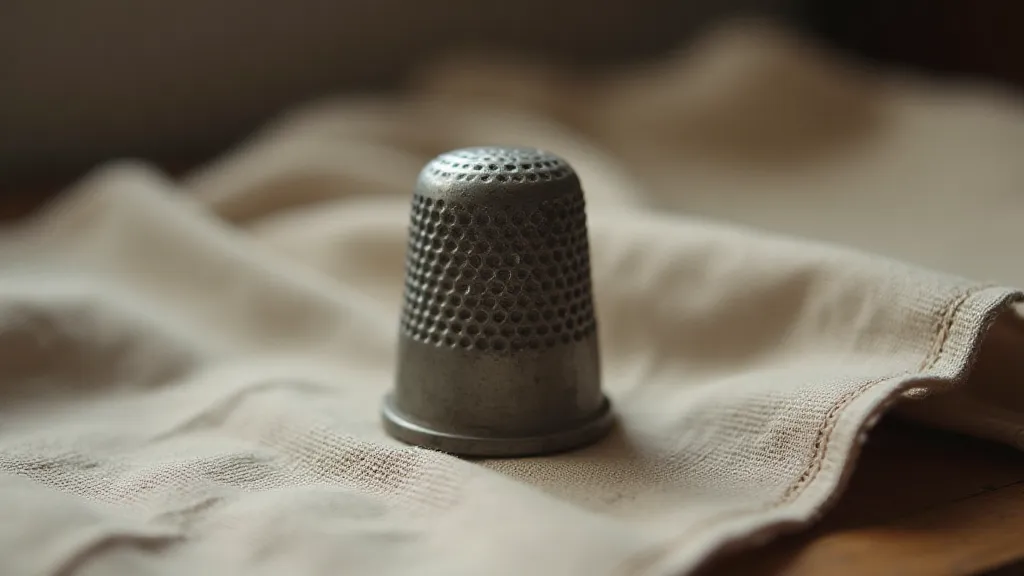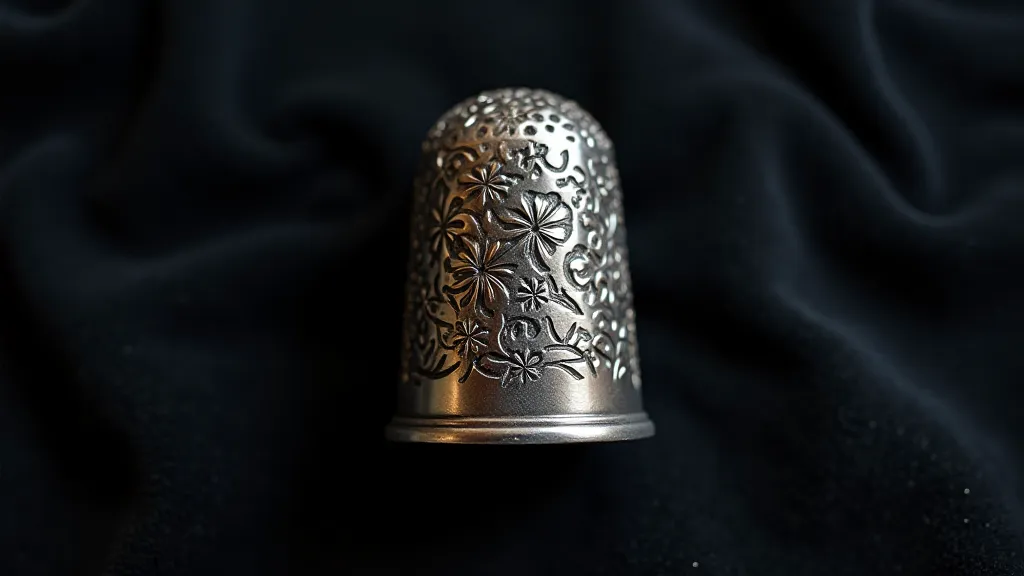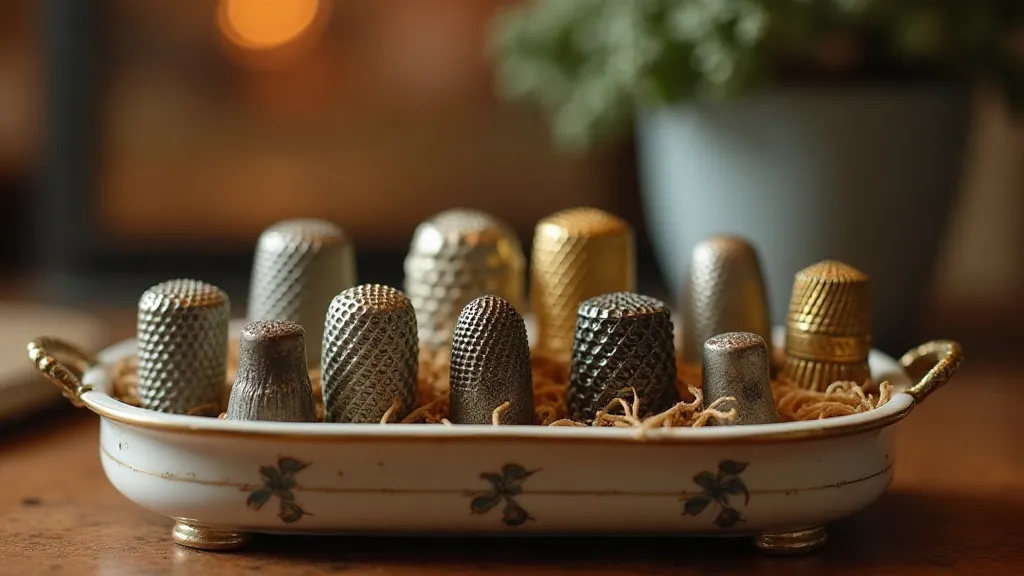The Alchemy of Stitch: Transforming Base Metals into Heirloom Treasures
There's a quiet magic in holding an antique thimble. It’s more than just a small, unassuming object; it's a miniature time capsule, a tangible link to the women – and sometimes men – who painstakingly crafted garments and stitched lives together through generations. My grandmother, Elsie, kept a small collection tucked away in a porcelain box, each one a testament to her own meticulous sewing and a whispered story of those who came before her. Picking one up – a simple pewter piece – I’d imagine her nimble fingers, guiding needle and thread, lost in the rhythm of creation. It wasn’s just sewing; it was an act of love, of necessity, of quiet artistry.
Most of us, in our modern world of fast fashion and mass production, rarely consider the journey of a humble thimble. Yet, understanding the processes behind its creation, the alchemy of transforming base metals into these miniature treasures, unlocks a profound appreciation for the skill and dedication of bygone artisans. The sheer artistry involved is astounding when you consider how the world of hand-sewing fostered a unique connection between maker and object, a connection that’s arguably less prominent in our age of mass production. It begs the question: what stories do these little vessels hold of the lives behind them? Consider exploring the ghost of the seamstress and the lives woven into the fabric of history—and embodied within these tiny tools.

From Pewter to Plate: The Foundations of a Thimble’s Being
The earliest thimbles weren’t always metal. Initially, they were finger stalls made from leather, bone, or even fruit pits. But the introduction of metal, particularly pewter, marked a significant shift in the history of sewing and the development of the thimble. Pewter, an alloy of tin, copper, and antimony, offered a robust and relatively inexpensive material. The process of creating pewter thimbles involved melting the alloy, pouring it into molds (often simple sand molds), and then painstakingly filing and smoothing the resulting piece. Early pewter thimbles were typically plain, functional objects, reflecting the immediate need for protection against the constant pricking of the needle.
Silver thimbles followed, offering a touch more elegance and status. Silverworking demanded a higher level of skill, involving techniques like raising, chasing, and engraving. These processes were significantly more complex than pewter production, requiring specialized tools and a deep understanding of metal behavior. The surface would be hammered and shaped, then intricate designs could be added using punches and chisels. Imagine the focused concentration, the years of apprenticeship required to master such techniques.
The Rise of Sterling: A Mark of Quality and Status
Sterling silver, an alloy containing 92.5% silver and 7.5% other metals (typically copper), truly elevated the thimble into a coveted collectible. Sterling thimbles weren’t just tools; they were miniature works of art, often passed down through families as heirlooms. The hallmarks on a sterling thimble – tiny, often barely visible stamps – act as a coded history, revealing the maker’s identity, the assay office where it was tested, and the date of manufacture. Deciphering these hallmarks can be a fascinating journey into the world of antique silver collecting. The artistry of crafting these items wasn't always straightforward; the design often reflected regional preferences and evolved over time. Those interested in understanding these nuances might enjoy learning more about the language of embellishment and identifying regional thimble styles.
The Victorian era (1837-1901) saw an explosion in the popularity of elaborate silver thimbles. Mass production techniques, while still limited compared to today, allowed for greater detail and complexity in the designs. Floral motifs, intricate scrollwork, and even miniature portraits were common, reflecting the aesthetic sensibilities of the time. This period witnessed a huge demand for these small, beautiful objects, feeding an appetite for ornamentation that permeated all aspects of Victorian life.
Gold's Glimmer: The Pinnacle of Opulence
Of course, the pinnacle of thimble luxury lies with those crafted from gold. Gold thimbles were, and remain, incredibly rare, representing a symbol of immense wealth and status. They were often commissioned for royalty or gifted as tokens of profound affection. The crafting of a gold thimble required the utmost precision and artistry. Lost-wax casting, a complex process involving creating a wax model, encasing it in investment material, melting out the wax, and then pouring molten gold into the resulting cavity, was often employed. The surface could then be polished to a dazzling shine, sometimes adorned with precious stones or enamel.
My grandfather, a quiet man who rarely spoke of his past, once mentioned a gold thimble his own grandmother possessed. He recalled it shimmering under the light of the oil lamp, a fleeting glimpse of privilege and a connection to a life he could scarcely imagine. That single image, shared with such understated reverence, cemented my fascination with antique thimbles. Considering the circumstances surrounding ownership, one might reflect on the broader context of hand-sewing and its role in society; it seems likely that these intricate processes often fostered deep connections between maker and object, connections that may now feel increasingly distant. The enduring link between the act of sewing and the objects it produced has shaped our history in profound ways.

Beyond the Metal: Decoration and Detail
While the metal itself dictates the thimble’s inherent value and historical significance, the decorative elements further enhance its charm and collectibility. Engraving, as mentioned, was a particularly popular technique, allowing artisans to create incredibly detailed images and patterns. Repoussé, a method of hammering metal from the reverse side to create a raised design, added another layer of dimension. Enameling, the process of fusing colored glass powder to metal, introduced vibrant hues and intricate designs.
The presence of personal inscriptions, initials, or dates can significantly increase a thimble's sentimental value and sometimes its monetary worth. These marks offer a direct connection to the original owner, providing a glimpse into their life and history. Finding a thimble with a loved one’s name etched into its surface feels almost like uncovering a secret message from the past. The artistry involved in crafting these small treasures underscores a forgotten world where craft and sentiment were intertwined. The way that hand-sewing was practiced, and the objects it created, weren't just about function; they were about preserving memory and connection.
Caring for Your Treasures: Preservation and Appreciation
Antique thimbles are delicate objects that require careful handling and storage. Avoid harsh chemicals and abrasive cleaners. Gentle polishing with a soft cloth can help maintain their luster. Proper storage in a padded case or drawer protects them from scratches and tarnish. More than just preserving the physical object, however, is preserving the story it carries. Researching its hallmarks, understanding its manufacturing process, and appreciating the craftsmanship involved will enrich your appreciation for this small but significant piece of history.
The rapid shift toward mass production and disposable fashion has left a void in our appreciation for the artistry and dedication of bygone eras. Perhaps, by preserving these tiny relics and understanding their history, we can rekindle a sense of connection to the past and a deeper appreciation for the value of handcrafted objects. The ephemeral nature of existence is often reflected in these small items; their very fragility underscores the importance of cherishing them and honoring the traditions they represent. It's a poignant reminder of how the act of creating, of carefully and intentionally assembling something beautiful and functional, is a profoundly human experience. As a society, we're moving further away from these practices, but perhaps by looking back we can learn to value them again. Consider reflecting on ephemeral echoes and the vanishing art of hand-sewn textiles and thimble companionship—a poignant commentary on the passage of time and the fading of traditions.
It’s a quiet joy, holding a piece of the past, connecting with the hands that shaped it, the lives it touched. The alchemy of stitch, transforming base metals into heirloom treasures, is a testament to human ingenuity, artistry, and the enduring power of creation. Like my grandmother’s porcelain box, holding its collection of thimbles, these tiny treasures tell a larger story – a story of family, of tradition, and of the enduring beauty of the handmade.

The influence of sewing patterns wasn’t limited to fabric construction; it often shaped the design and details of the thimbles themselves. These patterns dictated shapes, sizes, and embellishments, leading to a fascinating interplay between fashion and toolmaking. The way patterns influenced thimble design provides a window into a bygone era where tools and textiles were intrinsically linked. For those fascinated by this connection, examining glimpses through a loophole offers a unique perspective on the artistic influence of sewing patterns on thimble design.





